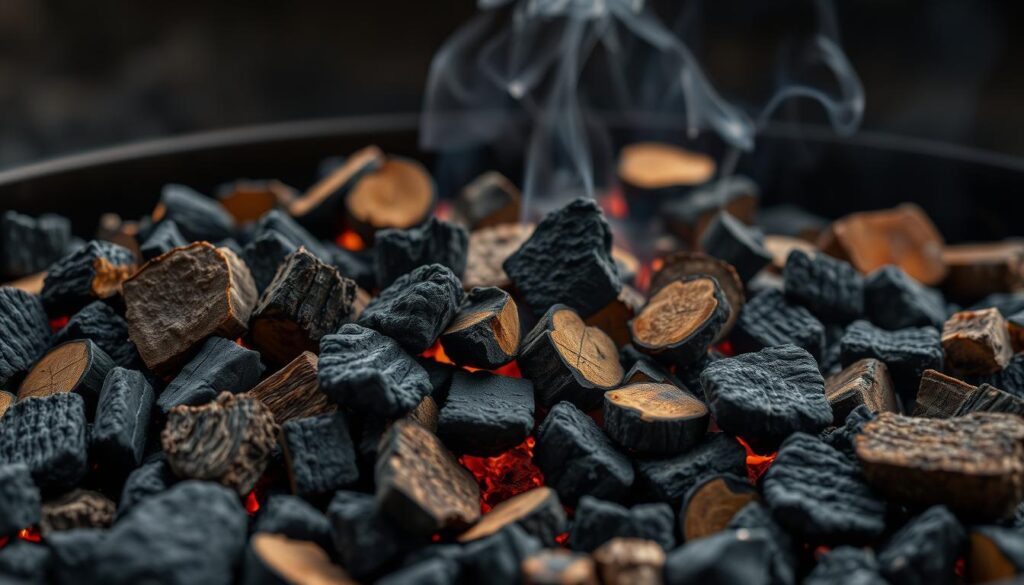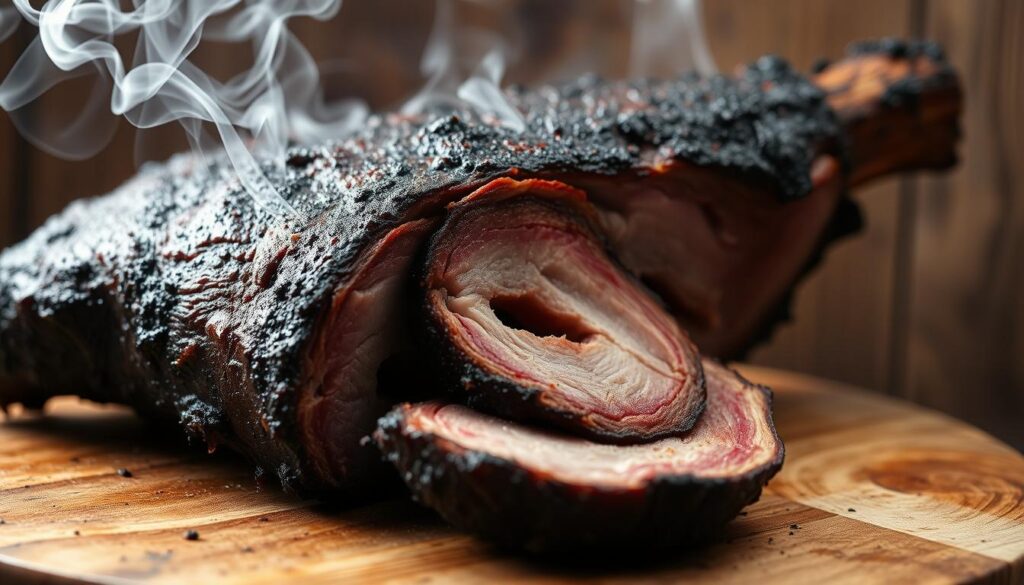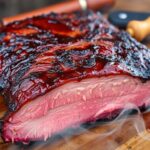Secrets to Achieving a Perfect Smoke Ring in BBQ Competitions
Ever wondered what makes competition BBQ so special? It’s the pink ring under the meat’s surface, known as the smoke ring. This ring shows off a pit master’s skills. But how do you get this ring in your own BBQ? Let’s explore the science and techniques behind it.
This will make your BBQ stand out, impressing everyone with your skills.
Key Takeaways
- Understand the chemical reaction that creates the smoke ring
- Learn how to maintain the optimal temperature and moisture levels for smoke ring formation
- Discover the wood types and combustion methods that enhance smoke penetration
- Master the art of low and slow cooking to achieve competition-worthy results
- Leverage meat science principles to select the perfect cuts for a flawless smoke ring
What is a Smoke Ring?
A smoke ring is a pink or reddish band that appears on smoked meats like brisket and pork. It’s a result of a chemical reaction between the meat’s myoglobin and smoke gases. These gases include nitric oxide (NO) and carbon monoxide (CO).
The Cause of a Smoke Ring
When smoke gases meet the myoglobin in the meat, they change its color. This keeps the meat pink. The smoke ring forms because these gases only go deep into the meat. This leaves the inside to cook and turn brown, while the outside stays pink.
The process of creating a smoke ring is complex. It involves the meat’s myoglobin reacting with smoke gases. This mix of elements gives smoked meats their unique look.
“The smoke ring is a visual cue that the meat has been properly smoked, and it also indicates that the meat has been exposed to the right combination of smoke, heat, and time.”
Learning about smoke ring formation helps you get it right in your BBQ. By understanding smoke, temperature, and meat, you can make perfect smoke rings every time.
Does a Smoke Ring Enhance Flavor?
In barbecue, the smoke ring is often seen as a mark of excellence. This pinkish-red ring forms below the meat’s surface, showing a well-smoked brisket or pork shoulder. But, the idea that a big smoke ring means the meat tastes better is a barbecue myth.
The visual appeal of smoke ring can make the meat look more appealing. But, it doesn’t actually make the flavor of the barbecue better. The smoke ring comes from a chemical reaction between the meat and smoke. It doesn’t affect the meat’s natural taste or quality.
In competition judging, the smoke ring is very important. Judges often look for a thick smoke ring to show the pitmaster’s skill. Even though the smoke ring doesn’t change the taste, it can affect how the meat is judged in a barbecue competition.
“The smoke ring is a beautiful visual indicator, but it doesn’t mean the meat will taste any better. It’s really just for show.”
The debate over the smoke ring flavor is ongoing in the barbecue world. Some believe it’s crucial, while others think the real test is the meat’s tenderness, juiciness, and flavor. This is true whether or not it has a vibrant smoke ring.
Factors Influencing Smoke Ring Formation
Getting a perfect smoke ring in BBQ isn’t just about the method. It’s also about several key factors. These include the meat’s myoglobin content, the cooking temperature, and the type of wood used. Knowing these can help you improve your smoked dishes.
Myoglobin Content
Myoglobin, a protein in muscle tissue, is key for smoke ring formation. Beef has the most myoglobin, making it great for a deep smoke ring. Pork and poultry have less, but older animals have more, leading to a deeper ring.
Meat Temperature
The meat’s temperature is also crucial. If it gets too hot inside, the myoglobin won’t react with the smoke compounds. This limits the smoke ring’s depth and color. Cooking low and slow lets the smoke fully interact with the myoglobin.
Wood Type and Combustion
The wood type and how it burns affect the smoke ring too. Hardwoods like oak and hickory make more NO and CO than softwoods. Lower burning temperatures help produce these compounds consistently. This lets them deeply penetrate the meat and react with the myoglobin.
“Understanding the factors that influence smoke ring formation is crucial for BBQ enthusiasts who want to take their game to the next level.”
Techniques for Achieving a Perfect Smoke Ring
Getting a beautiful smoke ring on your barbecued meats shows you know your stuff. Start with the right meat, like beef brisket or pork shoulder. These meats are full of myoglobin, which helps them take on the smoke’s color.
It’s important to cook at low and slow temperatures. High heat can ruin the smoke ring by changing the meat before the smoke can work its magic. Stick to temperatures between 225°F and 275°F for the best look.
Keeping the meat’s outside wet is key. Use a spray or brush with apple juice or broth to help the smoke stick and deepen the color. Cutting off extra fat helps the smoke get in better and makes the colors pop.
| Technique | Benefit |
|---|---|
| Choosing Meat with High Myoglobin | Primes the meat to absorb and showcase smoke’s hue |
| Maintaining Low and Slow Temperatures | Prevents myoglobin from denaturing before smoke penetration |
| Keeping the Meat Surface Moist | Helps smoke chemicals adhere and condense for a more distinct ring |
Use these tips, and you’ll soon be making smoke rings that wow everyone at your barbecues.
Perfect Smoke Ring for BBQ Competition
In competitive barbecue, the competition-level smoke ring is key. Judges look for a thick, even smoke ring to see if the meat was smoked right. This ring doesn’t change the taste but can influence judges who eat with their eyes first.
Pitmasters work hard to get a perfect smoke ring. It can mean the difference between winning or losing. Getting this ring right takes knowing how it forms and controlling the cooking time and temperature.
- Selecting the right cut of meat with a high myoglobin content
- Maintaining a low and slow cooking temperature to ensure the smoke has time to permeate the meat
- Keeping the meat surface moist throughout the cooking process to facilitate smoke absorption
- Carefully monitoring the temperature to ensure the meat never exceeds the critical point where the smoke ring formation stops
By using these techniques, pitmasters can make meats with a competition-level smoke ring. This will impress judges and give them an edge in BBQ competitions.
Fuel Selection for Optimal Smoke Ring Formation
Choosing the right fuel is key to getting that perfect smoke ring in your BBQ. Charcoal briquettes and hardwood are top choices for pitmasters who want to boost nitric oxide (NO) production. This is what gives the meat that distinctive pink color.
Charcoal briquettes and hardwood chunks or chips are great together. They create the right mix of nitric oxide and carbon monoxide (CO). This mix is what makes the smoke ring look amazing. Gas and electric smokers often can’t make enough of these gases, so your meat might not get that beautiful smoke ring.
Charcoal Briquettes and Hardwood
For the best smoke ring, mix high-quality charcoal briquettes with hardwood fuel selection for smoke ring. The briquettes give steady, long heat, and the hardwood adds a smoky flavor and nitric oxide for the smoke ring.
“The secret to a show-stopping smoke ring lies in the fuel you choose. Charcoal briquettes and hardwood are a winning combination, delivering the perfect balance of heat, smoke, and nitric oxide production.”
Learning how to pick between charcoal vs. hardwood will help you make BBQ that looks and tastes amazing. The secret to a perfect smoke ring is choosing the right fuel.

Monitoring Meat Temperature for Smoke Ring Growth
Getting the perfect smoke ring in BBQ is an art that needs careful temperature control. The secret to a vibrant, well-defined smoke ring is to watch the meat’s internal temperature closely while it cooks.
The smoke ring gets bigger as the meat stays below a certain temperature. This temperature is around 170°F for beef. At this point, the myoglobin, which gives the ring its pink color, starts to break down. This means the smoke ring stops growing.
To get the biggest smoke ring, take the meat off the smoker before it hits this critical temperature. Many BBQ experts wrap the meat in butcher paper or foil at 160-165°F. This keeps it moist and stops the smoke ring from fading too soon.
| Meat Temperature | Smoke Ring Growth |
|---|---|
| Below 170°F | Smoke ring continues to expand |
| Above 170°F | Smoke ring stops growing as myoglobin denatures |
By keeping an eye on the meat’s temperature and using the right techniques, you can make your BBQ smoke ring stand out. This will impress BBQ judges and fans everywhere.
Controlling Bark Formation for Enhanced Smoke Penetration
A thick bark on meat can block smoke gases from getting in. Seasoned pitmasters use smart tricks to delay bark formation. This lets more smoke get into the meat, making it taste better.
Delaying Bark Formation
One way to do this is by keeping the meat moist. You can spray or mop it often. This slows down the drying of the outside, which helps delay bark formation.
Wrapping the meat in butcher paper or foil after some bark forms also works well. It keeps moisture in and stops more bark from growing. This lets the smoke keep getting into the meat.
Learning how to control bark formation is key to a great smoke ring. It makes your smoked food look and taste amazing. This is important if you’re in a BBQ competition.

| Technique | Benefit |
|---|---|
| Frequent Spritzing or Mopping | Slows the drying and hardening of the exterior, delaying bark formation |
| Wrapping in Butcher Paper or Foil | Traps moisture and prevents further bark development, enabling ongoing smoke absorption |
Using these methods to manage bark formation and delay bark development is smart. It helps create a stunning smoke ring. This will surely impress any BBQ judge.
Electric Smoker Hacks for Achieving a Smoke Ring
Getting a perfect smoke ring with an electric smoker can be tough. These smokers don’t create the same smoke gases as charcoal or wood-fired ones. But, there are some workarounds for electric smokers to help you get a good smoke ring.
One good trick is to put a little charcoal or hardwood in the smoker’s wood chip tray. This can make more smoke gases, like those from traditional smokers. Another trick is to use a curing salt with sodium nitrite. This can make the meat look like it has a real smoke ring in electric smoker.
- Incorporate charcoal or hardwood chunks in the wood chip tray to boost smoke gas production.
- Utilize a curing salt with sodium nitrite to artificially create the smoke ring effect.
With these smart tricks, even those who use electric smokers can get a smoke ring that looks amazing. It will impress your guests and other barbecue fans.
“With a few simple tricks, you can coax an electric smoker to produce a smoke ring that rivals the best charcoal or wood-fired units.”
Conclusion
The smoke ring is key to expertly smoked meats, especially in barbecue competitions. Its visual appeal adds to the meat’s quality and the pitmaster’s skill. Even if its taste impact is debated, the smoke ring’s look matters a lot.
Learning how smoke rings form helps you get a perfect one. It involves myoglobin, wood type, and how the wood burns. To get it right, keep the meat at low and slow temperatures. Also, keep the meat moist and choose the right fuel.
This guide gives you the tips you need to impress at your next barbecue. With these insights, you’ll make your smoked meats stand out. You’ll see the importance of smoke ring and how to get it perfect for amazing results.

Leave a Reply